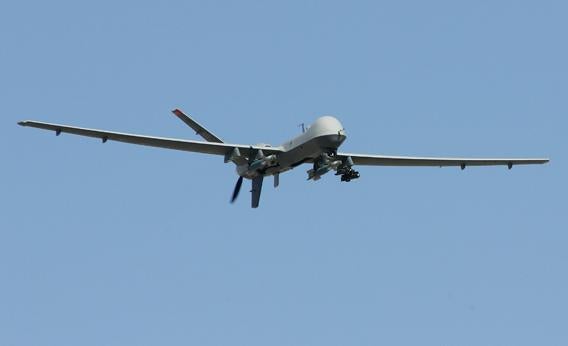A CIA drone strike in North Waziristan killed al-Qaida’s No. 2 leader on Monday. Pakistan again complained that drone strikes are “unlawful, against international law and a violation of [its] sovereignty,” but while the country has threatened to shoot down unmanned vehicles in the past, it has never followed through. How hard is it to kill a drone?
It depends on the model. Shooting down an MQ-1 Predator or an MQ-9 Reaper, the propeller-driven drones most commonly used to kill terrorists in Pakistan, would be child’s play for a Pakistani Air Force pilot. They’re easy to detect on radar, and they fly at about 100 mph—about the speed of a World War I-era bomber. (The Dassault Mirage 5, one of the most common jets in Pakistan’s military fleet, cruises at just under 600 mph and tops out at nearly 1,500 mph.) They don’t normally carry any weapons that could be used in a dogfight, and their lack of maneuverability makes them vulnerable to missiles fired from the ground.
While the Predator and the Reaper are easy targets, the military has other, more sophisticated drones. The RQ-170 Sentinel, for example, is much more difficult to detect on radar, and its jet engines enable it to fly at just below the speed of sound. In the months before Osama Bin Laden’s killing, Sentinels flew between the seams of Pakistan’s radar systems to spy on his Abbottabad compound. But if the Pakistanis did spot a Sentinel, it wouldn’t be impossible to destroy. Military experts still argue over whether the Sentinel that went down in Iran last year was shot or simply malfunctioned.
At least two countries have brought down U.S. drones in the past. Serbian air defense destroyed 15 of them during the NATO bombing of Yugoslavia in 1999. (There were even rumors that the Serbians managed to hit one with a machine gun fired from an open helicopter door.) In 2002, a Predator drone equipped with air-to-air Stinger missiles took on an Iraqi MiG in the no-fly zone. The drone was easily dispatched.
Pakistan’s reluctance to make good on its threat to shoot down a U.S. drone has nothing to do with capability—it’s just part of the complex relationship between the two countries. While Pakistan’s civilian leaders bristle at U.S. military operations inside the country, the Pakistani military sometimes finds drone attacks useful. Many intelligence analysts, for example, believe that the Pakistanis were far more interested than U.S. officials in the 2009 killing of Baitullah Mehsud, a terrorist leader who was likely involved in the assassination of Benazir Bhutto. The CIA may have used its drones to hunt down Mehsud in part as a favor.
Got a question about today’s news? Ask the Explainer.
Explainer thanks Peter W. Singer of Brookings, author of Wired for War: The Robotics Revolution and Conflict in the 21st Century. Thanks also to reader Derek Hansen for asking the question.
